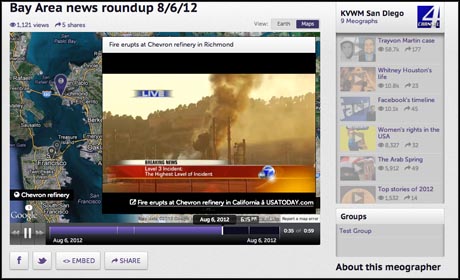
Storytelling platform Meograph, which enables users to produce a multimedia package by plotting stories on a map and timeline, is to introduce paid-for option with features aimed at journalist users.
The platform announced this week that it had launched its "first premium licence", aimed at users in the education sector, but that premium features for news outlets would follow in the coming months.
Meograph first launched last year, giving users the ability to produce a package of content to tell a story over time, and with the ability to also mark each development on a map. The example below is one given by Meograph on the demo part of its site.

Speaking to Journalism.co.uk, Meograph founder Misha Leybovich said the licence unveiled this week offers educators three key features: "sub-account creation, group management and private sharing".
This enables a group of account users, which in the education sector could apply to a class of students, to have their Meographs collected under one overarching user, such as a teacher.
While this is currently only available for education users, Leybovich said "journalists have asked for the same kind of thing".
"You could have a newsroom and all the reporter accounts could be sub-accounts to the editor or the producer," he explained. This would give a news outlet a channel of its content, featuring a collection of the Meographs created by different journalists.
The licence also enables content to be published with specific privacy settings, such as to only be viewable to certain users.
Leybovich said these paid-for additions are "on the way for use in other verticals as well".
For journalists, the platform will offer additional features as part of a paid-for licence, on top of the sub-accounts, group management and privacy tools available to education users.
This will include the ability to personalise "the front end", such as by using their own logo and colours to make the end product appear "more like a native experience", as well as "custom content analytics".
These analytics can offer user data drilled down to the level of an individual image or Meograph 'moment', he said. Moments are the individual developments which together make up a complete package. Each 'moment' is given a timestamp and linked to a piece of related media, such as an image or video.
"We're instrumenting the player so that you can actually tell down to the 'moment', down to the narration within a moment or the picture, how much time people are spending on each element of your presentation, how much time they're spending, when they're dropping off, how they're interacting with their presentation because there's clickable things within the Meograph, how much they're viewing it and sharing it."
Users can then use that data to make decisions on how they might wish to improve a Meograph.
"What you can do is actually go in and change it. It's live and you don't have to re-embed it you don't have to re-upload it; you can take action right then and there."
He added that overall the aim is to "make it more and more of a powerful tool for journalists", as well as working on developing the free aspect of Meograph. According to Leybovich "95 per cent of what the tool can do is going to remain free".
"We want to be able to remain a free resource," he said. As for the cost of the paid-for features, Leybovich said this is still being discussed.
Asked whether collaborative production by more than one user of a Meograph at the same time will be possible, he added that this is "on our roadmap".
Free daily newsletter
If you like our news and feature articles, you can sign up to receive our free daily (Mon-Fri) email newsletter (mobile friendly).









